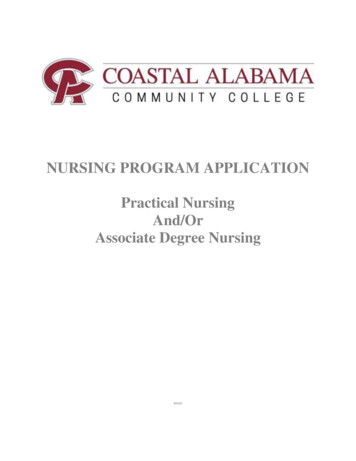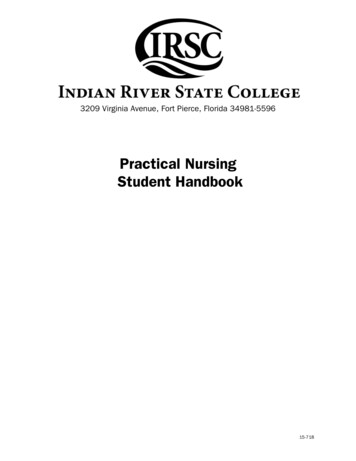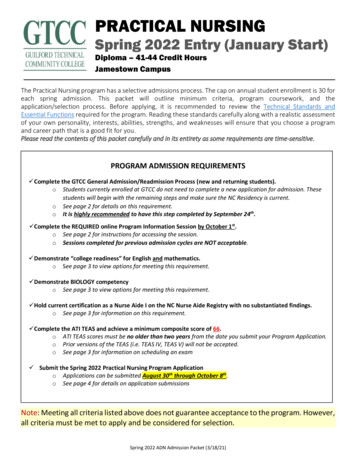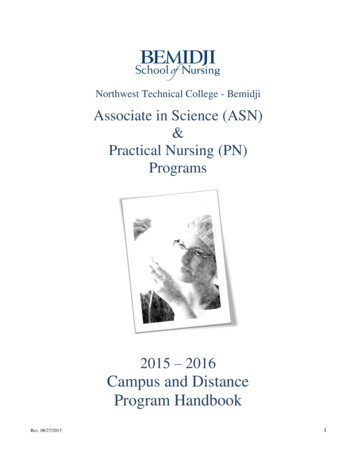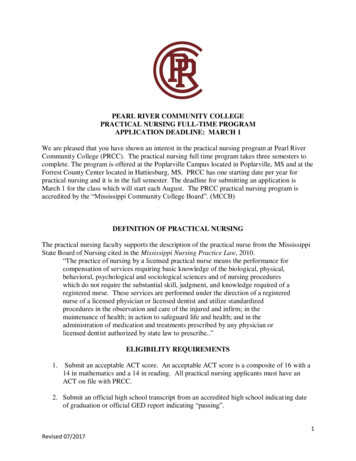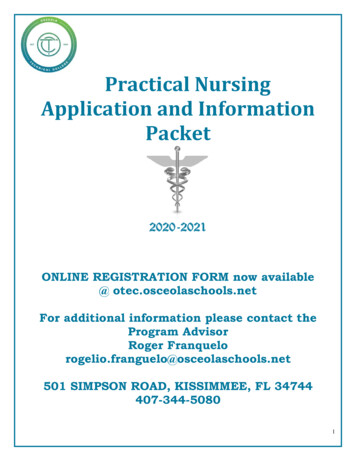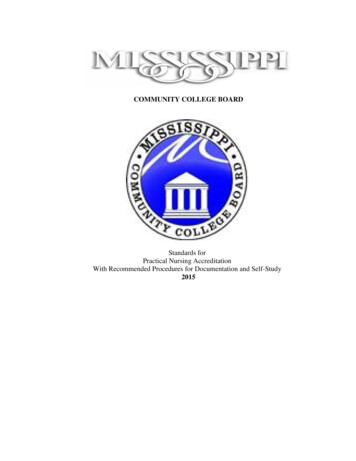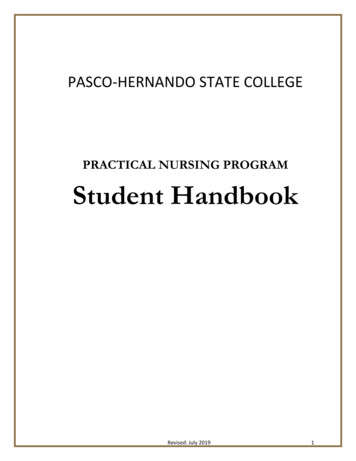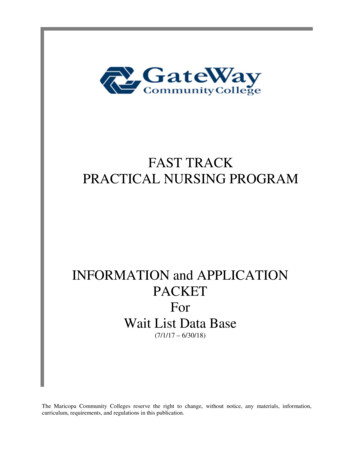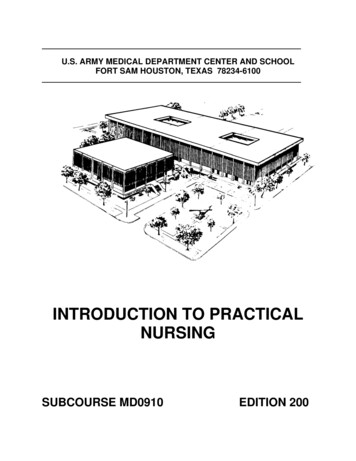
Transcription
U.S. ARMY MEDICAL DEPARTMENT CENTER AND SCHOOLFORT SAM HOUSTON, TEXAS 78234-6100INTRODUCTION TO PRACTICALNURSINGSUBCOURSE MD0910EDITION 200
DEVELOPMENTThis subcourse is approved for resident and correspondence course instruction. Itreflects the current thought of the Academy of Health Sciences and conforms to printedDepartment of the Army doctrine as closely as currently possible. Development andprogress render such doctrine continuously subject to change.The subject matter expert responsible for content accuracy of this edition was theNCOIC, Nursing Science Division, DSN 471-3086 or area code (210) 221-3086, M6Branch, Academy of Health Sciences, ATTN: MCCS-HNP, Fort Sam Houston, Texas78234-6100.ADMINISTRATIONStudents who desire credit hours for this correspondence subcourse must meeteligibility requirements and must enroll in the subcourse. Application for enrollmentshould be made at the Internet website: http://www.atrrs.army.mil. You can access thecourse catalog in the upper right corner. Enter School Code 555 for medicalcorrespondence courses. Copy down the course number and title. To apply forenrollment, return to the main ATRRS screen and scroll down the right side for ATRRSChannels. Click on SELF DEVELOPMENT to open the application and then follow theon screen instructions.For comments or questions regarding enrollment, student records, or examinationshipments, contact the Nonresident Instruction Branch at DSN 471-5877, commercial(210) 221-5877, toll-free 1-800-344-2380; fax: 210-221-4012 or DSN 471-4012, e-mailaccp@amedd.army.mil, or write to:NONRESIDENT INSTRUCTION BRANCHAMEDDC&SATTN: MCCS-HSN2105 11TH STREET SUITE 4191FORT SAM HOUSTON TX 78234-5064CLARIFICATION OF TERMINOLOGYWhen used in this publication, words such as "he," "him," "his," and "men" 'are intendedto include both the masculine and feminine genders, unless specifically stated otherwiseor when obvious in context.
TABLE OF CONTENTSLESSONPARAGRAPHSINTRODUCTION1THE PRACTICAL NURSE IN THE AMEDDSection I. Review of the AMEDDSection II. The Role of the M6Exercises1-1---1-111-12--1-182THE M6 PRACTICAL NURSE COURSEExercises2-1--2-73DUTIES AND RESPONSIBILITIES OF THE M6 PRACTICAL NURSESectionI. Clinical Duties and Responsibilities of theM6 Practical NurseSection II. Managerial Duties and Responsibilities of theM6 Practical NurseExercisesMD0910i3-1--3-73-8--3-13
CORRESPONDENCE COURSE OFTHE U.S. ARMY MEDICAL DEPARTMENT CENTER AND SCHOOLSUBCOURSE MD0910INTRODUCTION TO PRACTICAL NURSINGINTRODUCTIONThe purpose of this subcourse is to introduce you to the ASI M6, Practical Nurse.The M6 practical nurse is an important link in the chain of health care providers withinthe Army Medical Department. The M6 serves in the dual roles of providing experttechnical support to professional health care providers, while functioning as an enlistedmilitary leader.The M6 practical nurse is equivalent to the civilian occupation of licensedpractical/vocational nurse. Because the Practical Nurse Course is approved by theTexas Board of Vocational Nurse Examiners, graduates of the course are eligible toapply for licensure examination and take the National Council Licensure Examination(NCLEX) for Practical Nurses. By simply maintaining licensure in the state of yourchoice, your ASI becomes a civilian occupation that will be available to you at thecompletion of your military career.The NCLEX-PN is a one-day, three-hour, computer-based examinationdesigned by the National Council of State Boards of Nursing to test thegraduate's ability to practice practical nursing in a safe, effective manner.Licensure is required to maintain the ASI M6.The M6 Practical Nurse Preparatory Correspondence Course is designed to bestudied by the prospective M6. If you have not yet decided to apply for the resident M6Course, this introductory subcourse will provide you with an overview of the duties,responsibilities, knowledge, and skills required of the practical nurse. With thisinformation, you should be better prepared to decide whether practical nursing is foryou. The M6 course is difficult and demanding. Maximum preparation is desirable forsuccessful completion of the resident course. AMEDD personnel expecting to attendthe 300-M6 Practical Nurse Course are encouraged to complete the M6 Practical NursePreparatory Correspondence Course in advance of resident training. The completion ofthe M6 correspondence course does not result in the awarding of the M6 ASI.When you have passed all of the subcourses in the M6 correspondence course,a certificate of completion will be awarded to you. You should maintain a copy of thiscertificate and a copy will be placed in your official 201 file. (Nonmilitary studentsshould carry or mail a copy of the certificate to the local Directorate of Civilian Personnelfor entry in their personnel file.)MD0910ii
The following list of suggested references is offered to assist you with yourstudies. These references should be available through the learning resource centerand/or the library on your post. You will find them quite helpful as study and resourcematerial during both your correspondence work and resident course work.FM 4-25.11, First Aid.FM 22-100, Army Leadership.STP 21-1-SMCT Soldier's Manual of Common Tasks SL1.Shier, D., J. Butler, and R. Lewis. Hole’s Essentials of Human Anatomy andPhysiology, 8th ed. Dubuque, Iowa: McGraw, 2003.Kurzen, C. Contemporary Practical/Vocational Nursing, 4th ed. Philadelphia:Lippincott, 2001.Burton, G. Microbiology for the Health Sciences, 7th Ed. Philadelphia: J.B.Lippincott, 2003.Krause, A. Food, Nutrition & Diet Therapy, 10th ed. Philadelphia: W.B.Saunders, 2000.Barry, P. Mental Health and Mental Illness, 7th ed. Philadelphia: Lippincott,2002.Christensen, B. and E. Kockrow. Foundations of Nursing, 4th ed. St Louis:Mosby, 2002.Christensen, B. and E. Kockrow. Adult Health Nursing, 4th ed. St Louis:Mosby, 2003.Rosdahl, Caroline B. Textbook of Basic Nursing, 8th ed. Philadelphia:Lippincott, 2003.Timby, B. and N. Smith. Introductory to Medical Surgical Nursing, 8th ed.Philadelphia: Lippincott, 2003.Scherer, J. & S. Roach. Introductory Clinical Pharmacology, 7th ed.Philadelphia: Lippincott, 2003.Thompson, E.D. and G. Leifer. Introduction to Maternity and Pediatric Nursing,4th Ed. Philadelphia: W.B. Saunders, 2002.MD0910iii
Subcourse Components:This subcourse consists of three lessons. The lessons are:Lesson 1. The Practical Nurse in the AMEDD.Lesson 2. The M6 Practical Nurse Course.Lesson 3. Duties and Responsibilities of the M6 Practical NurseHere are some suggestions that may be helpful to you in completing thissubcourse:--Read and study each lesson carefully.--Complete the subcourse lesson by lesson. After completing each lesson, workthe exercises at the end of the lesson, marking your answers in this booklet.--After completing each set of lesson exercises, compare your answers with thoseon the solution sheet that follows the exercises. If you have answered an exerciseincorrectly, check the reference cited after the answer on the solution sheet todetermine why your response was not the correct one.Credit Awarded:To receive credit hours, you must be officially enrolled and complete anexamination furnished by the Nonresident Instruction Branch at Fort Sam Houston,Texas. Upon successful completion of the examination for this subcourse, you will beawarded 3 credit hours.You can enroll by going to the web site http://atrrs.army.mil and enrolling under"Self Development" (School Code 555).A listing of correspondence courses and subcourses available through theNonresident Instruction Section is found in Chapter 4 of DA Pamphlet 350-59, ArmyCorrespondence Course Program Catalog. The DA PAM is available at the followingwebsite: 10iv
LESSON ASSIGNMENTLESSON 1The Practical Nurse in the AMEDD.LESSON ASSIGNMENTParagraphs 1-1 through 1-17.LESSON OBJECTIVESAfter completing this lesson, you should be able to:SUGGESTIONMD09101-1.Describe the mission of the AMEDD inpeacetime and during mobilization.1-2.State the four major functions of the AMEDD.1-3.Define the health services support area concept.1-4.Describe the levels of combat health support inthe field.1-5.List the major duties of the practical nurse in theAMEDD.1-6.Describe the various roles of the M6 practicalnurse in the AMEDD.After reading and studying the assignment, complete theexercises at the end of this lesson. These exercises willhelp you to achieve the lesson objectives.1-1
LESSON 1THE PRACTICAL NURSE IN THE AMEDDSection I. REVIEW OF THE AMEDD1-1.THE ARMY MEDICAL DEPARTMENT (AMEDD)a. The personnel who comprise the Army Medical Department (AMEDD) areassigned to medical units and to positions that call for personnel with specialized healthservice training. The AMEDD consists of the following.(1) The Office of The Surgeon General.(2) The six officer corps.(a) The Medical Corps (MC).(b) The Army Nurse Corps (AN).(c) The Dental Corps (DC).(d) The Veterinary Corps (VC).(e) The Medical Service Corps (MS).(f) The Army Medical Specialist Corps (SP).(3) Warrant Officers.(4) Enlisted personnel.(5) Civilian employees.(6) AMEDD facilities, supplies, and equipment necessary for the mission.b. The mission of the Army Medical Department is to maintain the health of theArmy and conserve its fighting strength. Care is provided for eligible personnel inpeacetime and, at the same time, preparations are made for health support of the Armyin time of war, international conflict, or natural disaster. The four major functions of theAMEDD are:(1) The selection of only the physically and mentally fit persons for militaryservice.MD09101-2
(2) The prevention of unnecessary hazards to the health and efficiency oftroops through a health and environment program.(3) The medical treatment of those who become sick or injured and theirprompt return to duty or other disposition as appropriate.(4) The prompt evacuation of patients from the combat zone to medicaltreatment facilities designed to provide the type and extent of treatment required.c. The AMEDD purpose is to provide the U.S. Army with the world's besttrained, equipped, and supported leaders, soldiers, and civilians, ready to providequality health service support in any environment across the operational continuum.1-2.U.S. ARMY MEDICAL COMMANDa. The U.S. Army Medical Department Command (MEDCOM) is a major Armycommand under the direction of Headquarters, Department of the Army. AMEDDpersonnel are found in all major Army commands (MACOM). MEDCOM's mission is toprovide health services for the Army in the continental United States (CONUS) andother areas and organizations as directed by the Chief of Staff, U.S. Army. TheMEDCOM has the additional mission of providing medical, dental, and veterinaryeducation and training for AMEDD personnel and other personnel as directed.b. The AMEDD provides health services to eligible personnel under the areasupport concept. The territory to which the AMEDD provides health services is dividedinto seven geographical areas of responsibility. Each of these has been designated asa health service region (HSR). Each HSR contains one U.S. Army Medical Center(MEDCEN). The health service regions are normally subdivided into two or more healthservice areas (HSA). A health service area is a geographical area for which a singlemedical treatment facility (MTF) has responsibility for providing health care services toauthorized personnel within that area. For example, if a health service region containsa MEDCEN and three MEDDACs, this HSR would be divided into four health serviceareas. One HSA would have the MEDCEN as its primary MTF and each of the otherHSAs would have one of the U.S. Army Medical Department Activities (MEDDAC) as itsprimary medical treatment facility.c. A U.S. Army Medical Center (MEDCEN) is a specialized medical treatmentand teaching facility that provides general and specialized medical and dental care andtreatment. A U.S. Army Medical Department Activity (MEDDAC) is a fixed MTF withassociated activities, all of which are responsible for providing health services.d. Health services for areas not under the AMEDD are provided by AMEDDpersonnel within other MACOMs. For example, the 7th Medical Command inHeidelberg, Germany, is under the major Army command United States Army, Europe(USAREUR).MD09101-3
1-3.HEALTH SERVICE SUPPORT AREA CONCEPTa. Under the Health Service Support Areas (HSSA) concept, the MEDCOMcoordinates medical care in six regions of the United States with command authority ineach region and subordinate commands for dental and veterinary services.b. In November 1993, subordinate commands for the U.S. Dental Command(DENCOM) and Veterinary Command (VETCOM) were provisionally activated. Underthe MEDCOM, Commanders of the Dental Service Support Areas (DSSA) integrate andcoordinate dental care within their geographic areas of operation. The DSSA are sevenregional organizations that parallel the Health Service Support Areas (HSSA) in themedical arena. The VETCOM controls seven Veterinary Service Support Areas(VSSA), whose boundaries may differ from the HSSA and DSSA because of DefenseDepartment responsibilities.c. Six medical centers have command and control over medical treatmentfacilities in their HSSA. These regional organizations are responsible for deliveringhealth care in the AMEDD structure. The HSSAs are headquartered at Walter Reed,Eisenhower, Brooke, William Beaumont, Madigan, and Tripler Army Medical Centers.1-4.COMBAT HEALTH SUPPORT IN THE FIELDa. Combat health support (CHS) is provided for the Army in the field in war andpeace by the utilization of a variety of medical modules and echelons of care. Themedical system is functionally designed to prevent, collect, assess, treat, evacuate, andrehabilitate sick or injured soldiers. The combat health support system is designed toproject, sustain, and protect the health of the soldier in war and operations other thanwar (OOTW). Consistent with strategic and tactical operations, CHS operates across alloperational levels, from the forward line of own troops (FLOT) to the continental UnitedStates (CONUS) sustaining base. It is a system that provides continuous medicalmanagement throughout all echelons of care.MD09101-4
(1) The goals of the Army's CHS system in support of warfighting are to:(a) Reduce the incidence of disease and nonbattle injuries (DNBI)through sound preventive medicine programs.(b) Provide medical and surgical treatment for acute illnesses, injuries,or wounds.(c) Evacuate patients through the echelons of care to the appropriatemedical treatment facility (MTF) commensurate with requisite care.(d) Maintain soldiers on duty or promptly return to duty (RTD) those whohave recovered.(e) Maintain a robust and aggressive science and technology base toenhance all capabilities related to health and the delivery of health care.(2) These goals are the embodiment of the CHS battle field rules:(a) Maintain medical presence with the soldier (be there).(b) Maintain the health of the command.(c) Save lives.(d) Clear the battlefield.(e) Provide state-of-the-art care.(f) Ensure early return to duty.b. Combat health support is arranged in levels or echelons of care. Each levelof care reflects an increase in capability, yet the functions of each lower level of supportare contained within the capabilities of all higher levels. The basic levels of healthservice support are the unit level, the division level, the corps level, the communicationzone (COMMZ) level, and the CONUS support base.c. The health service support system represents a continuum of care, beginningat the FLOT (forward line of own troops) and ending in the CONUS base. Each soldieris evacuated rearward only to that level of health service support having the medicaltreatment capabilities necessary to treat that patient's injuries. The objective of healthservice support in the field is to treat the soldier as far forward as possible and to returnhim to duty as soon as he is able.d. Unit and division level medical care organizations are based on a modulardesign. In the future, modular components will even be employed at the corps andMD09101-5
COMMZ level. The system used at the division level and forward is comprised of sixbasic models as listed below.(1) Combat medic. This module consists of one medic with a prescribed loadof medical supplies and equipment. Combat medics are assigned to the medicalplatoon or section of the combat support battalions and are attached to the companiesof the battalions as required.(2) Treatment squad. The treatment squad consists of a primary carephysician, a physician assistant (PA), and six medical specialists. The squad is trainedand equipped to provide advanced trauma management (ATM) to the battlefieldcasualties. Advanced trauma management is physician or physician assistant directedcare. It is designed to resuscitate and stabilize the patient for evacuation to the nextechelon of medical care or to treat and return him to duty. Advanced traumamanagement provides maximum benefit if received within 60 minutes of injury. Tomaintain contact with the combat maneuver elements, each squad has two emergencytreatment vehicles. Each squad can split into two treatment teams. These squads areorganic to medical platoons or sections in maneuver battalions and designated combatsupport units. This module is the building block of the medical company.(3) Ambulance squad. The ambulance squad module is comprised of fourmedical specialists and two ambulances. This squad operates in conjunction with thetreatment squad. The squad provides patient evacuation throughout the operationalcontinuum and care in route. Each ambulance carries a medical equipment set (MES)that includes intravenous fluids, oxygen, bandages, and splints, as well as other medicalsupplies and equipment to enable patient monitoring. In conjunction with the treatmentsquad, there is the capability to acquire a patient within 30 minutes of wounding, treatthe patient, and coordinate for the rapid evacuation to the next level of care.Ambulance squads are organic to medical platoons and sections of maneuver battalionsand squadrons, selected combat support units, divisional and nondivisional medicaltreatment companies, and ground ambulance companies of the medical evacuationbattalion.(4) Area support squad. This module is composed of a dental officer, adental specialist, an x-ray specialist, a laboratory specialist, and associated medicalequipment set (MES). The dentist is trained in advanced trauma management toaugment the capabilities of the physician and/or physician assistant during periods ofincreased treatment requirements. The area support squad is organic to medicalcompanies within the brigade support area, division support area, corps support area, orthe COMMZ.(5) Patient holding squad. This module is composed of practical nurses,medical specialists, and a medical equipment set (MES) specifically designed for themission of the squad. Each squad is capable of providing limited medical support forminimal care patients who are expected to return to duty within 72 hours. Patientholding squads are assigned to a treatment platoon of the medical company.MD09101-6
(6) Forward surgical team. This module is staffed with two surgeons, twonurse anesthetists, a medical/surgical nurse, two operating room specialists, and twopractical nurses. The forward surgical team is organized to provide early resuscitativesurgery for seriously wounded or injured patients, to save life, and to preserve physicalfunction. Early surgery is performed whenever a likely delay in the evacuation of apatient threatens life or the quality of recovery. This team collocates with the patientholding squad where postsurgical patients awaiting evacuation are held. The forwardsurgical team provides the required nursing care. Forward surgical teams are organicto the airborne
THE PRACTICAL NURSE IN THE AMEDD Section I. REVIEW OF THE AMEDD 1-1. THE ARMY MEDICAL DEPARTMENT (AMEDD) a. The personnel who comprise the Army Medical Department (AMEDD) are assigned to medical units and to positions that call for personnel with specialized health service training. The AMEDD consists of the following.File Size: 424KB

